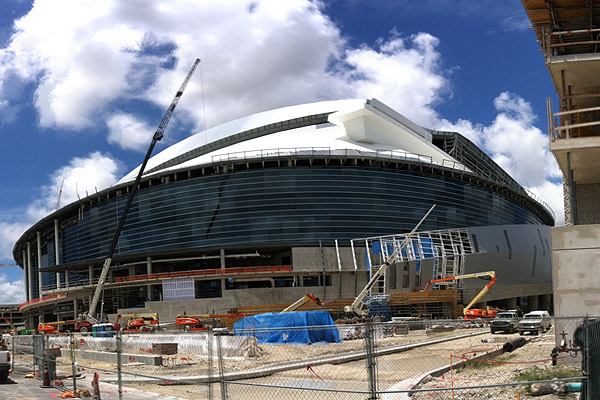
The Cubs got Theo Epstein from the Red Sox and Jed Hoyer from the Padres, and the eyes of baseball turned to Wrigleyville to see, so far, the acquisition of respectable veteran David DeJesus and a trade of two .150 hitters. While they got their front-office men, the most exciting team in the hot-stove league has been the Miami Marlins, who have gone on a spending spree not seen in baseball since… well, since they were the Florida Marlins.
All this is being done to put a good product on their new field, an attractive $634 million stadium that's drawn the interest of the Securities and Exchange Commission. But public financing might not be the only liability. As Eric Jaffe of The Atlantic Cities points out, for all the hundreds of millions of dollars of taxpayer money devoted to the park, neither the team nor the city has addressed public transportation at all. And as Transit Miami's Tony Garcia writes, the public-transit access is surpassingly bad:
I have to wonder why these people believe that anyone would go through the trouble of transferring two or three times to get close to the stadium, to then walk a mile from Culmer or Civic station or take a shuttle. Are they nuts? Both of the closest stations are about a mile, without taking into account the treacherous 3′ sidewalks, dangerous intersections, and completely lacking pedestrian amenities along the way.
It's a problem in and of itself, but it's a bigger problem since parking capacity is lacking:
The parking garages only have 4,700 spaces, with an additional 3,500- 4,000 (stretching it) for folks parking on lawns and on-street around the stadium.
This might seem like a minor issue to me had I not just read Jonah Keri's The Extra 2%, about the Tampa Bay Rays' worst-to-first turnaround. It purports to be about the sophisticated "Wall Street strategies" that the team used to build a good team on the cheap in the hardest division in baseball, but as far as the business content, it's as strong or stronger on the less sexy, workaday customer service and public relations strategies they adopted to burnish the franchise's local reputation after a Scrooge of an owner nearly burned it to the ground. A lot of it is little things: concerts after ballgames, local discounts for folks wearing Rays paraphrenalia, and suchlike, all meant to give the team a friendlier image after a decade of overt hostility towards its fan base. It's basic strategy, but as Keri points out, just improving attendence a bit can be enough to sign a valuable role player, like playoff hero Dan Johnson.
And the Rays did get people interested, and they did turn around the team, and they've been competitive ever since. Attendance went up—from 2008 through 2010, the Rays averaged about 5,000 more fans per game than they did before the team got good. But it's still not very good attendance:
Shortly after the team’s loss to the Texas Rangers in the American League Division Series — which saw only 28,299 fans show — Tampa Bay Rays owner Stuart Sternberg launched into the troubling financial situation of his franchise….
[snip]
The Rays have two AL East titles, a World Series appearance and three postseason appearances in four seasons, but have averaged exactly 1,748 more fans per game than they did in 2007, when they lost 96 games.
Unfortunately, the lack of attendance has a direct effect on the Rays’ ability to spend money. After attendance issues last year both in the regular season and postseason, the Rays slashed payroll by around $30 million.
In short, the Rays went up over 20,000 fans per game for three years, but attendance in 2011 fell back under that mark.
A big reason for this, Keri notes, is that Tropicana Field isn't just dumpy; it's very hard to get to. It's on a peninsula in St. Petersburg, meaning it's connected by bridge to Tampa, choking off access. According to Keri, getting there by car requires doubling whatever estimate Google Maps gives you. As far as public transportation, it's even worse: to get from the University of Tampa to Tropicana at 2:30 eastern on a Monday, Google Maps gives me an estimate of nearly two hours to go 25 miles—a good half hour to 45 minutes longer than Northwestern to the Cell, a slightly shorter distance.
Baseball teams would do well to learn from the Cubs, for whom a bad year for attendance is a good year for almost every other team in baseball. And they do this with a minimum of parking around the stadium, the opposite of the conventional wisdom about sports stadiums, whose quality seems to be in inverse proportion to the amount of parking immediately adjacent to the park. Pac Bell in San Francisco, my favorite in all of baseball, does have a nearby lot—but it's set away from the park across a bridge, while the stadium itself abuts a typical city block.
I'm always surprised this approach isn't more appealing (the Twins' new home did 99 percent attendance last year, and it's at "the sweet spot for public transit in Minnesota"). The Cubs can break 90 percent attendance with a lousy product. The Rays, handcrafted from the finest Wall Street algorithims and perpetually in contention for the playoffs against the most expensive and storied teams in baseball, have trouble breaking 60 percent. Nice as it is to win games and have famous, talented players, there's something to be said for a subway stop.
Photograph: miamism (CC by 2.0)



Comments are closed.